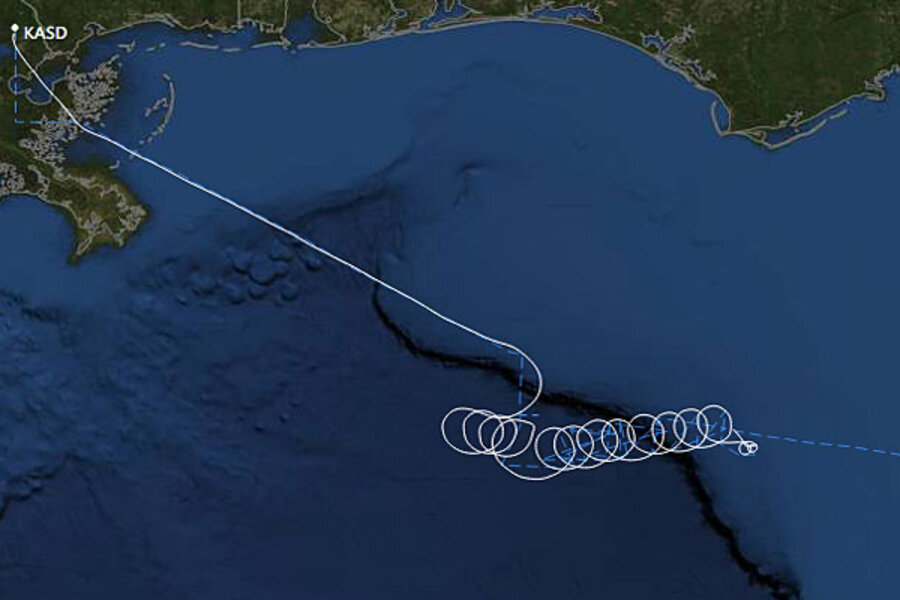Unresponsive Cessna: What caused the plane crash?
Loading...
| Pensacola, Fla.
Coast Guard crews saw no signs Thursday that the pilot of a small plane survived when his Cessna went down in the Gulf of Mexico about three hours after two F-15 fighter jets tried to make contact with him.
Coast Guard Chief John Edwards said the plane landed right-side up on the ocean surface and had been floating right after the crash. Planes did not see a life raft deploy or anything to indicate the pilot — the lone person aboard — was alive, the Coast Guard said.
The twin-engine Cessna 421C later sank into the Gulf about 120 miles (200 kilometers) west of Tampa, Fla., in about 1,500 feet (460 meters) of water. A C130 and a helicopter were looking for debris from the submerged plane, said Petty Officer Elizabeth Borderland. A Coast Guard cutter would remain in the area all night, she said.
RELATED: Six stories from a veteran flight attendant
Federal Aviation Administration spokeswoman Kathleen Bergen said the plane was flying from Slidell, Louisiana, to Sarasota, Florida. She said controllers lost contact with the pilot at 9 a.m. (1400 GMT). The Coast Guard said it went down about 12:10 p.m. (1710 GMT).
Two F-15 fighter jets tried to make contact with the plane at 8:45 EDT (1345 GMT) and were flying with it and monitoring it, but weren't able to hail the pilot, said North American Aerospace Defense Command spokesman John Cornelio. The jets' pilots reported that the Cessna's windshield was iced over and that the plane was fluctuating between 25,000 and 35,000 feet (7,600 and 10,700 meters).
Speculation has begun that that a lack of oxygen at that altitude could have caused the pilot to lose consciousness. Comparisons have been made between this Cessna crash and the crash of professional golfer Payne Stewart.
In 1999, a charter jet crash killed pro golfer Payne Stewart and four others and flew halfway across the country on autopilot before crashing in a pasture in South Dakota. Everyone on board had apparently lost consciousness for lack of oxygen after a loss of cabin pressure, and the Learjet crashed after it ran out of fuel, investigators said.
Authorities have not identified the pilot. But Bill Huete, a mechanic at the Slidell Airport, said Dr. Peter Hertzak, an OB-GYN who worked in the community just northeast of New Orleans, was the only person who piloted the plane. Huete said the doctor's wife told him her husband was flying the plane that morning.
Huete had worked on the plane for Hertzak and knew the doctor and his family for years.
"I met him years ago when he was looking to start flying again and bought this plane," said Huete.
Huete described Hertzak as an excellent pilot. "He flew by the book and he didn't scrimp on maintenance," Huete said.
No one answered the door at an address listed for Hertzak and calls to the home rang unanswered. Hertzak's office said any statement would have to come from his family and the Coast Guard said it wouldn't release the name for 24 hours according to its policy.
A computer-generated image provided by FlightAware, a private aviation flight path service, shows the plane traveling in several circles over the Gulf for hours before going down.
The two F-15s from the New Orleans National Guard were already on a mission over the Gulf, Coast Guard Chief John Edwards said in a news release. The Jacksonville Air Traffic Control Center asked the military if jets could check on the plane that was orbiting near one of Eglin Air Force Base's warning areas over the Gulf, Edwards said. Eglin is located on Florida's Panhandle.
___
Associated Press writers Kevin McGill in Slidell, Louisiana, Colleen Slevin in Denver and Randall Chase in Dover, Delaware, contributed to this report.
Copyright 2012 The Associated Press.





